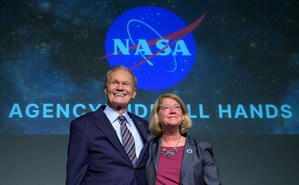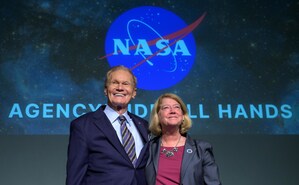WASHINGTON, March 14, 2019 /PRNewswire/ -- Three crew members have arrived safely at the International Space Station, following a successful launch and docking of their Soyuz MS-12 spacecraft Thursday.
The Soyuz spacecraft carrying Nick Hague and Christina Koch of NASA and Alexey Ovchinin of the Russian space agency Roscosmos launched at 3:14 p.m. EDT (12:14 a.m. Friday Baikonur time) from the Baikonur Cosmodrome in Kazakhstan. Hague, Koch and Ovchinin docked to the space station's Rassvet module at 9:01 p.m. after a four-orbit, six-hour journey, and are scheduled to open the hatch and be welcomed aboard the orbiting laboratory at approximately 11:10 p.m. Their mission, Expedition 59, officially began at the time of docking.
The arrival of Hague, Koch and Ovchinin restores the station's crew complement to six. They have joined Anne McClain of NASA, David Saint-Jacques of the Canadian Space Agency and Expedition 59 Commander Oleg Kononenko of Roscosmos.
The crew members will spend more than six months conducting about 250 science investigations in fields such as biology, Earth science, human research, physical sciences, and technology development. Seventy-five of the investigations are new and have never been performed in space. Some of the investigations are sponsored by the U.S. National Laboratory on the space station, which Congress designated in 2005 to maximize its use for improving quality of life on Earth.
Highlights of upcoming investigations include devices that mimic the structure and function of human organs, free-flying robots, and an instrument to measure Earth's distribution of carbon dioxide.
Three resupply spacecraft - a Russian Progress, Northrop Grumman Cygnus and SpaceX Dragon - are scheduled to arrive with science to support those investigations and additional supplies for the crew.
Hague, Koch, McClain and Saint Jacques soon will begin final preparations to venture outside the station's Quest airlock for three planned spacewalks. On March 22 and 29, pairs of spacewalkers will replace nickel-hydrogen batteries with newer, more powerful lithium-ion batteries for power channels on one pair of the station's solar arrays. On April 8, spacewalkers will lay out jumper cables between the Unity module and the midpoint of the station's backbone to establish a redundant power path to the Canadian-built robotic arm, known as Canadarm2, and enhance computer network capabilities. The March 29 spacewalk with McClain and Koch is scheduled to be the first-ever spacewalk with all-female spacewalkers. As with all spacewalks, crew member assignments are subject to change due to real-time operations.
The crew also is scheduled to be onboard during test flights of NASA's Commercial Crew Program, which will return human spaceflight launches for space station missions to U.S. soil.
McClain, Saint-Jacques and Kononenko are scheduled to remain aboard the station until June, while Hague, Koch and Ovchinin are set to return to Earth early this fall.
Hague and Ovchinin now have completed a journey to the station that initially was planned for Oct. 11, when a booster separation problem with their Soyuz rocket's first stage triggered an abort two minutes after launch, resulting in a safe return to Earth. They were reassigned to fly again after McClain, Kononenko and Saint-Jacques launched for Expedition 58 in early December. This is Ovchinin's third flight into space, the second for Hague and the first for Koch. NASA selected all three astronauts in the Expedition 59 crew in the 2013 astronaut class.
For more than 18 years, humans have lived and worked continuously aboard the station, advancing scientific knowledge and demonstrating new technologies, making research breakthroughs not possible on Earth that will enable long-duration human and robotic exploration into deep space, including the Moon and Mars. A global endeavor, 236 people from 18 countries have visited the unique microgravity laboratory that has hosted more than 2,500 investigations from researchers in 106 countries. Investigations conducted on the International Space Station impact the daily lives of people on Earth and prepare the way for humans to venture farther into space.
Follow Koch, Hague and McClain on their space mission at:
https://twitter.com/Astro_Christina
https://twitter.com/AstroHague
https://twitter.com/AstroAnnimal
Get breaking news, images and features from the space station on social media at:
and
https://www.twitter.com/Space_Station
SOURCE NASA
Related Links
WANT YOUR COMPANY'S NEWS FEATURED ON PRNEWSWIRE.COM?
Newsrooms &
Influencers
Digital Media
Outlets
Journalists
Opted In





Share this article